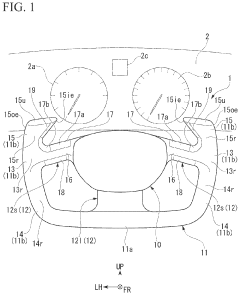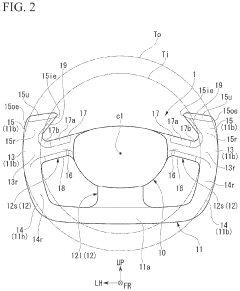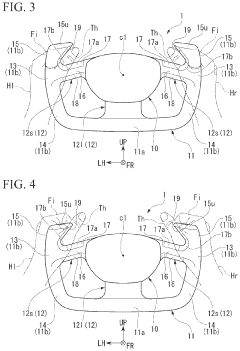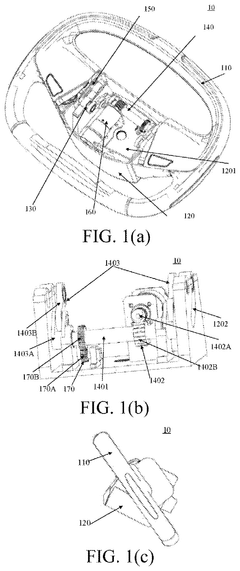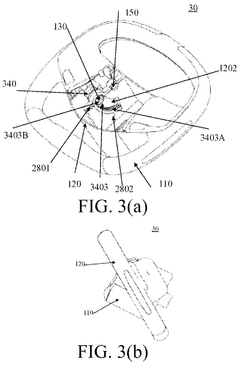Steering Wheel Developments: Enhancing Urban Transportation
JUL 18, 20259 MIN READ
Generate Your Research Report Instantly with AI Agent
Patsnap Eureka helps you evaluate technical feasibility & market potential.
Steering Tech Evolution
The evolution of steering wheel technology in urban transportation has undergone significant transformations over the years. Initially, steering wheels were purely mechanical devices, directly connected to the vehicle's steering system. As automotive technology advanced, power steering systems were introduced, reducing the physical effort required to maneuver vehicles, especially in urban environments with frequent turns and stops.
The next major leap came with the integration of electronic systems into steering wheels. This phase saw the introduction of steering-wheel-mounted controls for various vehicle functions, such as audio systems, cruise control, and phone connectivity. These advancements aimed to enhance driver convenience and reduce distractions by keeping hands on the wheel.
In recent years, the focus has shifted towards intelligent steering systems. The advent of drive-by-wire technology has allowed for more precise control and customization of steering feel. This technology replaces traditional mechanical linkages with electronic controls, enabling features like variable steering ratios that adapt to different driving conditions – a particularly useful feature in diverse urban environments.
The rise of advanced driver assistance systems (ADAS) has further revolutionized steering wheel technology. Features like lane-keeping assist and automated parking have begun to alter the fundamental role of the steering wheel in urban driving scenarios. These systems can provide subtle steering inputs to keep the vehicle centered in its lane or take over steering completely during parking maneuvers.
Looking towards the future, the concept of steer-by-wire systems is gaining traction. This technology completely eliminates the physical connection between the steering wheel and the wheels, relying entirely on electronic signals. This opens up new possibilities for steering wheel design and vehicle interior layouts, potentially transforming the urban driving experience.
The most recent developments in steering wheel technology are closely tied to the emergence of autonomous vehicles. As vehicles become more autonomous, the role of the steering wheel is being reimagined. Concepts like retractable steering wheels or steering wheels that transform into multifunctional control interfaces are being explored, anticipating a future where manual control may be optional in urban settings.
These technological advancements in steering systems are not just about improving vehicle control; they're increasingly focused on enhancing overall urban mobility. By making vehicles easier to maneuver in tight city spaces, more responsive to varying traffic conditions, and integrating with smart city infrastructure, steering wheel technology is playing a crucial role in shaping the future of urban transportation.
The next major leap came with the integration of electronic systems into steering wheels. This phase saw the introduction of steering-wheel-mounted controls for various vehicle functions, such as audio systems, cruise control, and phone connectivity. These advancements aimed to enhance driver convenience and reduce distractions by keeping hands on the wheel.
In recent years, the focus has shifted towards intelligent steering systems. The advent of drive-by-wire technology has allowed for more precise control and customization of steering feel. This technology replaces traditional mechanical linkages with electronic controls, enabling features like variable steering ratios that adapt to different driving conditions – a particularly useful feature in diverse urban environments.
The rise of advanced driver assistance systems (ADAS) has further revolutionized steering wheel technology. Features like lane-keeping assist and automated parking have begun to alter the fundamental role of the steering wheel in urban driving scenarios. These systems can provide subtle steering inputs to keep the vehicle centered in its lane or take over steering completely during parking maneuvers.
Looking towards the future, the concept of steer-by-wire systems is gaining traction. This technology completely eliminates the physical connection between the steering wheel and the wheels, relying entirely on electronic signals. This opens up new possibilities for steering wheel design and vehicle interior layouts, potentially transforming the urban driving experience.
The most recent developments in steering wheel technology are closely tied to the emergence of autonomous vehicles. As vehicles become more autonomous, the role of the steering wheel is being reimagined. Concepts like retractable steering wheels or steering wheels that transform into multifunctional control interfaces are being explored, anticipating a future where manual control may be optional in urban settings.
These technological advancements in steering systems are not just about improving vehicle control; they're increasingly focused on enhancing overall urban mobility. By making vehicles easier to maneuver in tight city spaces, more responsive to varying traffic conditions, and integrating with smart city infrastructure, steering wheel technology is playing a crucial role in shaping the future of urban transportation.
Urban Mobility Demands
Urban mobility demands have undergone significant transformations in recent years, driven by rapid urbanization, technological advancements, and changing consumer preferences. As cities continue to grow and evolve, the need for efficient, sustainable, and user-centric transportation solutions has become paramount. This shift in urban mobility demands has directly impacted the development of steering wheel technologies, pushing manufacturers and innovators to adapt and enhance their offerings.
One of the primary factors shaping urban mobility demands is the increasing population density in metropolitan areas. This has led to a surge in traffic congestion, prompting the need for more agile and responsive steering systems that can navigate through tight spaces and complex urban environments. Simultaneously, there is a growing emphasis on reducing carbon emissions and promoting sustainable transportation options, which has influenced the design and functionality of steering wheels in electric and hybrid vehicles.
The rise of shared mobility services and the potential for autonomous vehicles have also reshaped urban mobility expectations. Consumers now demand more flexible and interconnected transportation options, which in turn affects the design and functionality of steering wheels. There is an increasing focus on integrating smart features and connectivity options directly into the steering wheel, allowing for seamless interaction with various vehicle systems and external services.
Safety concerns remain a top priority in urban mobility, particularly given the complex and often unpredictable nature of city traffic. This has led to a demand for advanced driver assistance systems (ADAS) that can be seamlessly integrated with steering wheel technologies. Features such as lane departure warnings, collision avoidance systems, and adaptive cruise control are becoming standard expectations in urban vehicles, necessitating more sophisticated steering wheel designs that can accommodate these technologies.
The growing awareness of ergonomics and driver comfort in urban settings has also influenced steering wheel development. With urban commuters spending significant time behind the wheel, there is a demand for steering wheels that reduce fatigue and enhance the overall driving experience. This includes considerations for adjustable steering columns, tactile feedback mechanisms, and materials that improve grip and comfort during long periods of use.
Furthermore, the increasing adoption of electric powertrains in urban vehicles has implications for steering wheel design. The shift towards drive-by-wire systems and the elimination of traditional mechanical linkages opens up new possibilities for steering wheel configurations and functionalities. This trend aligns with the broader demand for more efficient and responsive urban mobility solutions.
One of the primary factors shaping urban mobility demands is the increasing population density in metropolitan areas. This has led to a surge in traffic congestion, prompting the need for more agile and responsive steering systems that can navigate through tight spaces and complex urban environments. Simultaneously, there is a growing emphasis on reducing carbon emissions and promoting sustainable transportation options, which has influenced the design and functionality of steering wheels in electric and hybrid vehicles.
The rise of shared mobility services and the potential for autonomous vehicles have also reshaped urban mobility expectations. Consumers now demand more flexible and interconnected transportation options, which in turn affects the design and functionality of steering wheels. There is an increasing focus on integrating smart features and connectivity options directly into the steering wheel, allowing for seamless interaction with various vehicle systems and external services.
Safety concerns remain a top priority in urban mobility, particularly given the complex and often unpredictable nature of city traffic. This has led to a demand for advanced driver assistance systems (ADAS) that can be seamlessly integrated with steering wheel technologies. Features such as lane departure warnings, collision avoidance systems, and adaptive cruise control are becoming standard expectations in urban vehicles, necessitating more sophisticated steering wheel designs that can accommodate these technologies.
The growing awareness of ergonomics and driver comfort in urban settings has also influenced steering wheel development. With urban commuters spending significant time behind the wheel, there is a demand for steering wheels that reduce fatigue and enhance the overall driving experience. This includes considerations for adjustable steering columns, tactile feedback mechanisms, and materials that improve grip and comfort during long periods of use.
Furthermore, the increasing adoption of electric powertrains in urban vehicles has implications for steering wheel design. The shift towards drive-by-wire systems and the elimination of traditional mechanical linkages opens up new possibilities for steering wheel configurations and functionalities. This trend aligns with the broader demand for more efficient and responsive urban mobility solutions.
Current Challenges
The current challenges in steering wheel developments for enhancing urban transportation are multifaceted and complex. One of the primary issues is the integration of advanced technologies into traditional steering systems without compromising safety or reliability. As urban environments become increasingly congested and complex, steering systems must evolve to provide more precise control and responsiveness in tight spaces and diverse traffic conditions.
Another significant challenge is the development of adaptive steering systems that can cater to various driving modes and preferences. Urban drivers often face a mix of high-speed highways and slow-moving city streets, requiring steering systems that can adjust sensitivity and feedback accordingly. This adaptability must be seamless and intuitive, enhancing the driving experience without causing confusion or discomfort.
The transition towards autonomous and semi-autonomous vehicles presents a unique set of challenges for steering wheel design. Engineers must develop systems that can seamlessly switch between human and computer control, maintaining safety and driver engagement. This includes addressing the psychological aspects of relinquishing control and ensuring that drivers remain alert and ready to take over when necessary.
Environmental concerns and the push for sustainability in urban transportation also impact steering wheel developments. There is a growing need for energy-efficient steering systems that can reduce the overall power consumption of vehicles, particularly in electric and hybrid models where energy management is crucial. This challenge extends to the materials used in steering wheel construction, with a focus on recyclable and eco-friendly components.
Ergonomics and user interface design present ongoing challenges in steering wheel development. As vehicles become more technologically advanced, steering wheels are increasingly expected to incorporate controls for various vehicle functions. Balancing the need for accessible controls with maintaining a clean, uncluttered design that doesn't distract from the primary task of driving is a significant hurdle for designers and engineers.
Lastly, the regulatory landscape poses challenges for steering wheel innovations. Safety standards and regulations vary across different regions, making it difficult to develop globally standardized solutions. Manufacturers must navigate these complex regulatory environments while still pushing the boundaries of innovation in steering technology.
Another significant challenge is the development of adaptive steering systems that can cater to various driving modes and preferences. Urban drivers often face a mix of high-speed highways and slow-moving city streets, requiring steering systems that can adjust sensitivity and feedback accordingly. This adaptability must be seamless and intuitive, enhancing the driving experience without causing confusion or discomfort.
The transition towards autonomous and semi-autonomous vehicles presents a unique set of challenges for steering wheel design. Engineers must develop systems that can seamlessly switch between human and computer control, maintaining safety and driver engagement. This includes addressing the psychological aspects of relinquishing control and ensuring that drivers remain alert and ready to take over when necessary.
Environmental concerns and the push for sustainability in urban transportation also impact steering wheel developments. There is a growing need for energy-efficient steering systems that can reduce the overall power consumption of vehicles, particularly in electric and hybrid models where energy management is crucial. This challenge extends to the materials used in steering wheel construction, with a focus on recyclable and eco-friendly components.
Ergonomics and user interface design present ongoing challenges in steering wheel development. As vehicles become more technologically advanced, steering wheels are increasingly expected to incorporate controls for various vehicle functions. Balancing the need for accessible controls with maintaining a clean, uncluttered design that doesn't distract from the primary task of driving is a significant hurdle for designers and engineers.
Lastly, the regulatory landscape poses challenges for steering wheel innovations. Safety standards and regulations vary across different regions, making it difficult to develop globally standardized solutions. Manufacturers must navigate these complex regulatory environments while still pushing the boundaries of innovation in steering technology.
Advanced Steering Systems
01 Steering wheel design and ergonomics
Innovations in steering wheel design focus on improving ergonomics and driver comfort. This includes optimizing the shape, size, and grip of the steering wheel to reduce fatigue during long drives and enhance control. Advanced materials and manufacturing techniques are employed to create steering wheels that are both functional and aesthetically pleasing.- Steering wheel design and ergonomics: Innovations in steering wheel design focus on improving ergonomics and driver comfort. This includes optimizing the shape, size, and grip of the steering wheel to reduce fatigue during long drives and enhance control. Advanced materials and manufacturing techniques are employed to create steering wheels that are both functional and aesthetically pleasing.
- Integration of controls and displays: Modern steering wheels incorporate various controls and displays to enhance driver convenience and safety. These may include buttons for audio control, cruise control, and voice commands, as well as small screens or heads-up displays for providing important vehicle information without requiring the driver to look away from the road.
- Steering wheel heating and cooling systems: To improve comfort in various weather conditions, steering wheels are being equipped with heating and cooling systems. These systems use embedded heating elements or ventilation channels to regulate the temperature of the steering wheel surface, enhancing grip and comfort for the driver.
- Advanced safety features in steering wheels: Steering wheels are being developed with advanced safety features such as airbag integration, impact-absorbing materials, and sensors for detecting driver grip and alertness. These innovations aim to improve occupant protection in the event of a collision and enhance overall vehicle safety.
- Adjustable and customizable steering wheels: Innovations in steering wheel design include adjustable and customizable features to accommodate different driver preferences and physical characteristics. This may involve telescoping and tilting mechanisms, interchangeable grip materials, and programmable button configurations to create a personalized driving experience.
02 Integration of controls and displays
Modern steering wheels incorporate various controls and displays to enhance driver convenience and safety. These may include buttons for audio control, cruise control, and voice commands, as well as small screens or heads-up displays for providing important vehicle information without requiring the driver to look away from the road.Expand Specific Solutions03 Steering wheel heating and cooling systems
To improve comfort in various weather conditions, steering wheels are being equipped with heating and cooling systems. These systems use embedded heating elements or ventilation channels to regulate the temperature of the steering wheel surface, enhancing grip and comfort for the driver.Expand Specific Solutions04 Advanced safety features in steering wheels
Steering wheels are being designed with advanced safety features to protect drivers in the event of a collision. This includes the integration of airbags directly into the steering wheel, as well as energy-absorbing materials and collapsible steering columns to reduce the risk of injury during impacts.Expand Specific Solutions05 Steering wheel materials and manufacturing
Innovations in materials science and manufacturing processes are being applied to steering wheel production. This includes the use of lightweight yet durable materials, such as carbon fiber composites, and advanced manufacturing techniques like 3D printing to create complex, customized steering wheel designs with improved performance characteristics.Expand Specific Solutions
Key Industry Players
The steering wheel development landscape in urban transportation is evolving rapidly, with the market in a growth phase characterized by increasing demand for advanced technologies. The global market size for steering systems is projected to expand significantly, driven by the rise of electric and autonomous vehicles. Technological maturity varies among key players, with established automotive giants like Honda, Hyundai, and Volkswagen leading in traditional steering systems. Emerging companies such as Autoliv and JTEKT are focusing on innovative solutions, including steer-by-wire and advanced driver assistance systems. Tier 1 suppliers like ZF Active Safety and Hyundai Mobis are also making significant strides in developing next-generation steering technologies, positioning themselves as crucial players in this competitive and dynamic market.
GM Global Technology Operations LLC
Technical Solution: GM has developed an advanced steering wheel system that integrates haptic feedback and gesture control to enhance urban driving experience. The system uses a combination of sensors and actuators embedded in the steering wheel to provide tactile alerts and warnings to the driver[1]. Additionally, the steering wheel incorporates capacitive touch sensors that can detect hand gestures, allowing drivers to control various vehicle functions without taking their hands off the wheel[2]. This technology is particularly useful in congested urban environments where quick reactions and minimal distractions are crucial. GM has also implemented a variable-ratio steering system that adjusts the steering response based on vehicle speed and driving conditions, improving maneuverability in tight city spaces[3].
Strengths: Enhanced driver awareness through haptic feedback, reduced distraction with gesture controls, improved maneuverability in urban settings. Weaknesses: Potential for system complexity and higher costs, may require driver adaptation period.
Volkswagen AG
Technical Solution: Volkswagen has introduced an innovative steering wheel system designed to address the unique challenges of urban transportation. Their technology features a shape-shifting steering wheel that can change its form factor to accommodate different driving modes and preferences in city environments[10]. In autonomous mode, the wheel can retract partially, providing more space and transforming into a control interface for infotainment and vehicle settings. The system incorporates advanced haptic feedback mechanisms that can communicate road conditions and navigation cues through subtle vibrations, reducing the need for visual distraction in busy urban settings[11]. Volkswagen has also developed a steering assist function that uses camera and sensor data to help drivers navigate tight parking spaces and narrow city streets more easily. Furthermore, the steering wheel integrates biometric sensors to monitor driver stress levels and fatigue, adjusting vehicle systems to promote safer urban driving[12].
Strengths: Adaptable form factor for various urban driving scenarios, enhanced tactile communication reduces visual distractions, stress monitoring promotes safer city driving. Weaknesses: Complex mechanical systems in shape-shifting design may increase maintenance needs, potential for information overload through multiple feedback channels.
Breakthrough Technologies
Steering wheel
PatentActiveUS20240208562A1
Innovation
- A steering wheel design featuring a non-annular rim part with an inflection section, upper and lower inclination surfaces, and a protrusion portion that allows for natural thumb placement and stable gripping, preventing hand displacement during rotation while maintaining forward visibility.
Steering wheel
PatentActiveUS12103582B2
Innovation
- A steering wheel design featuring a movable rim that rotates about a first axis and is connected to a pivot shaft, which pivots about a second axis via a transmission mechanism, allowing the rim to be easily stowed by a driving apparatus, with optional self-locking and angle measurement devices for precise positioning.
Smart City Integration
The integration of smart steering wheel technologies into urban transportation systems represents a significant leap towards creating more efficient, safe, and sustainable smart cities. As cities worldwide grapple with increasing population densities and traffic congestion, innovative steering wheel developments offer promising solutions to enhance urban mobility and overall quality of life.
Smart steering wheels equipped with advanced sensors and connectivity features can seamlessly interface with smart city infrastructure, creating a symbiotic relationship between vehicles and urban environments. These intelligent systems can receive real-time data from traffic management centers, adjusting routes dynamically to optimize traffic flow and reduce congestion. By leveraging machine learning algorithms, smart steering wheels can predict traffic patterns and suggest alternative routes, contributing to smoother urban transportation networks.
The integration of these technologies extends beyond mere traffic management. Smart steering wheels can interact with smart parking systems, guiding drivers to available parking spots and reducing the time spent searching for parking. This not only alleviates traffic congestion but also minimizes fuel consumption and emissions, aligning with smart cities' sustainability goals.
Furthermore, smart steering wheels can enhance public safety by interfacing with emergency response systems. In the event of an accident or medical emergency, these systems can automatically alert first responders and provide crucial information about the vehicle's location and condition. This rapid response capability can significantly improve outcomes in critical situations, making urban areas safer for all residents.
The data collected by smart steering wheels can also contribute to urban planning and infrastructure development. By aggregating anonymized data on traffic patterns, road conditions, and driver behavior, city planners can make informed decisions about infrastructure improvements, public transportation routes, and urban development strategies. This data-driven approach enables cities to allocate resources more efficiently and create transportation systems that better serve the needs of their residents.
As smart cities continue to evolve, the integration of advanced steering wheel technologies will play a crucial role in creating more responsive and adaptive urban environments. By fostering a seamless connection between vehicles and city infrastructure, these innovations have the potential to transform urban transportation, making cities more livable, efficient, and sustainable for future generations.
Smart steering wheels equipped with advanced sensors and connectivity features can seamlessly interface with smart city infrastructure, creating a symbiotic relationship between vehicles and urban environments. These intelligent systems can receive real-time data from traffic management centers, adjusting routes dynamically to optimize traffic flow and reduce congestion. By leveraging machine learning algorithms, smart steering wheels can predict traffic patterns and suggest alternative routes, contributing to smoother urban transportation networks.
The integration of these technologies extends beyond mere traffic management. Smart steering wheels can interact with smart parking systems, guiding drivers to available parking spots and reducing the time spent searching for parking. This not only alleviates traffic congestion but also minimizes fuel consumption and emissions, aligning with smart cities' sustainability goals.
Furthermore, smart steering wheels can enhance public safety by interfacing with emergency response systems. In the event of an accident or medical emergency, these systems can automatically alert first responders and provide crucial information about the vehicle's location and condition. This rapid response capability can significantly improve outcomes in critical situations, making urban areas safer for all residents.
The data collected by smart steering wheels can also contribute to urban planning and infrastructure development. By aggregating anonymized data on traffic patterns, road conditions, and driver behavior, city planners can make informed decisions about infrastructure improvements, public transportation routes, and urban development strategies. This data-driven approach enables cities to allocate resources more efficiently and create transportation systems that better serve the needs of their residents.
As smart cities continue to evolve, the integration of advanced steering wheel technologies will play a crucial role in creating more responsive and adaptive urban environments. By fostering a seamless connection between vehicles and city infrastructure, these innovations have the potential to transform urban transportation, making cities more livable, efficient, and sustainable for future generations.
Safety and Regulations
Safety regulations play a crucial role in the development and implementation of steering wheel technologies for urban transportation. As cities become more congested and complex, the need for robust safety measures in vehicles becomes increasingly important. Regulatory bodies worldwide have established stringent standards to ensure that steering systems meet the highest safety requirements.
One of the primary focuses of safety regulations is the mechanical integrity of steering wheels. These regulations mandate rigorous testing procedures to verify the durability and reliability of steering components under various conditions. Manufacturers must demonstrate that their steering systems can withstand extreme temperatures, vibrations, and impact forces without compromising functionality or safety.
Electronic stability control (ESC) systems have become a mandatory feature in many countries, integrated with steering systems to enhance vehicle control and prevent accidents. Regulations require these systems to intervene effectively in critical situations, such as during sudden maneuvers or on slippery surfaces, to maintain vehicle stability and reduce the risk of rollovers.
The advent of drive-by-wire technology in steering systems has prompted regulatory bodies to develop new standards specifically addressing the safety and reliability of electronic steering controls. These regulations focus on fail-safe mechanisms, redundancy in critical components, and cybersecurity measures to protect against potential hacking or malfunction of computerized steering systems.
As autonomous and semi-autonomous vehicles become more prevalent in urban environments, regulations are evolving to address the unique challenges posed by these technologies. Safety standards now include provisions for the seamless transition between automated and manual steering control, ensuring that drivers can quickly and safely take over when necessary.
Human-machine interface (HMI) regulations for steering systems have also gained prominence. These standards aim to minimize driver distraction and optimize the ergonomics of steering wheel designs. Regulations now cover aspects such as the placement and functionality of steering wheel-mounted controls, as well as the integration of haptic feedback systems to enhance driver awareness and response times.
In the context of urban transportation, regulations are increasingly focusing on the adaptability of steering systems to diverse urban environments. This includes requirements for enhanced maneuverability in tight spaces and improved responsiveness in stop-and-go traffic conditions typical of city driving.
As the automotive industry moves towards more sustainable practices, regulations are beginning to address the environmental impact of steering system production and disposal. This includes standards for the use of recyclable materials in steering wheel construction and guidelines for the safe disposal of electronic components in advanced steering systems.
One of the primary focuses of safety regulations is the mechanical integrity of steering wheels. These regulations mandate rigorous testing procedures to verify the durability and reliability of steering components under various conditions. Manufacturers must demonstrate that their steering systems can withstand extreme temperatures, vibrations, and impact forces without compromising functionality or safety.
Electronic stability control (ESC) systems have become a mandatory feature in many countries, integrated with steering systems to enhance vehicle control and prevent accidents. Regulations require these systems to intervene effectively in critical situations, such as during sudden maneuvers or on slippery surfaces, to maintain vehicle stability and reduce the risk of rollovers.
The advent of drive-by-wire technology in steering systems has prompted regulatory bodies to develop new standards specifically addressing the safety and reliability of electronic steering controls. These regulations focus on fail-safe mechanisms, redundancy in critical components, and cybersecurity measures to protect against potential hacking or malfunction of computerized steering systems.
As autonomous and semi-autonomous vehicles become more prevalent in urban environments, regulations are evolving to address the unique challenges posed by these technologies. Safety standards now include provisions for the seamless transition between automated and manual steering control, ensuring that drivers can quickly and safely take over when necessary.
Human-machine interface (HMI) regulations for steering systems have also gained prominence. These standards aim to minimize driver distraction and optimize the ergonomics of steering wheel designs. Regulations now cover aspects such as the placement and functionality of steering wheel-mounted controls, as well as the integration of haptic feedback systems to enhance driver awareness and response times.
In the context of urban transportation, regulations are increasingly focusing on the adaptability of steering systems to diverse urban environments. This includes requirements for enhanced maneuverability in tight spaces and improved responsiveness in stop-and-go traffic conditions typical of city driving.
As the automotive industry moves towards more sustainable practices, regulations are beginning to address the environmental impact of steering system production and disposal. This includes standards for the use of recyclable materials in steering wheel construction and guidelines for the safe disposal of electronic components in advanced steering systems.
Unlock deeper insights with Patsnap Eureka Quick Research — get a full tech report to explore trends and direct your research. Try now!
Generate Your Research Report Instantly with AI Agent
Supercharge your innovation with Patsnap Eureka AI Agent Platform!
